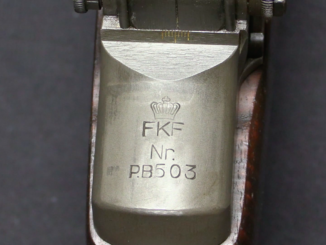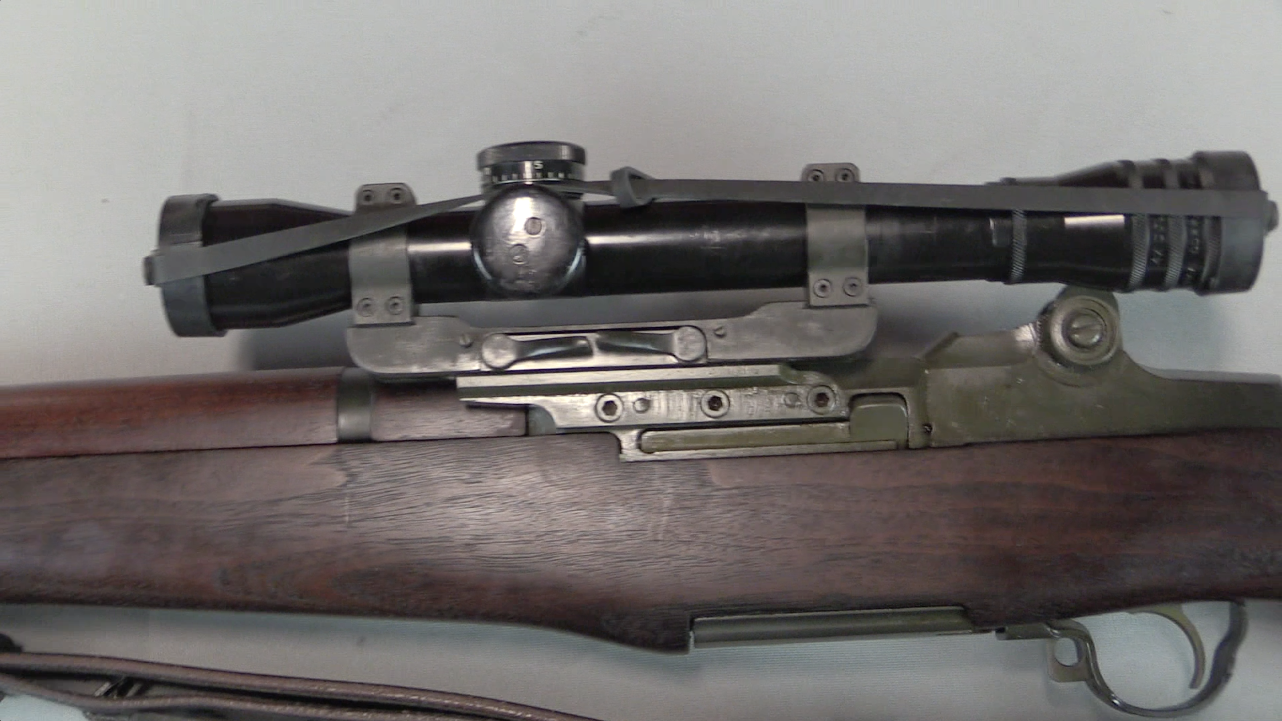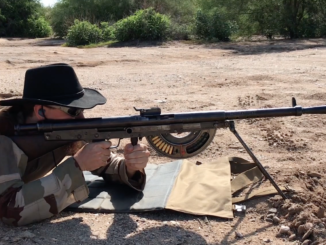Elmer Keith’s No.5 Single Action Army is arguably the most famous custom revolver ever made. Keith had it built in 1928 after developing a friendship with Harold Croft, another revolver enthusiast. Croft had shown Keith his own custom revolvers, which he had numbered 1 through 4. Croft had been trying to make an ideal pocket gun, and Keith used several of his ideas along with some of Keith’s own to put together a revolver for general-purpose field use. In recognition of Croft’s work, Keith called his gun Number 5. It featured an extended flat top with windage-adjustable sights, an improved mainspring, redesigned cylinder pin, custom hammer spur, and modified Bisley grip. It was chambered for the .44 Special/.44 Russian cartridges (the Russian being a slightly shorter version of the Special), and it was Keith’s favorite shooting piece until the .44 Magnum cartridge was introduced in the late 1950s. He described this gun in detail in a 1929 American Rifleman article entitled “The Last Word”.
Related Articles

Semiauto Rifles
Danish Gevaer m/50 – An American Gun Made in Italy
Dozens of countries around the world received M1 Garand rifles from the United States in the decades after World War Two, and Denmark was one of those that not only got some rifle but went […]

Semiauto Rifles
MC-1952 Marine Corps Sniper Garand
The MC-1952 was a variation on the M1C Garand sniper rifle, adopted by the US Marine Corps in 1952. The Marines were not satisfied with the low magnification of the Lyman scopes on the Army […]

Light MGs
8mm M1915 Chauchat Fixing and Range Testing
Well, my 8mm French Chauchat finally cleared transfer, as did my application to reactivate it. This was a “dewat”, or “Deactivated War Trophy” – a machine gun put on the NFA registry but modified to […]

“.44 Special/.44 Russian cartridges (the Russian being a slightly shorter version of the Special)”
It must be noted that .44 Special and .44 Russian are ballistic equal (unlike say .38 Special and .357 Magnum), early 20th century smokeless powder need more space to equal ballistic performance of older .44 Russian without increasing pressure
“it was Keith’s favorite shooting piece until the .44 Magnum cartridge was introduced in the late 1950s.”
What was popularity of following cartridge: 44 Special, 44-40 WCF, 45 Long Colt in 1920s/1930s? I have impression that the 44 Special was the least popular – the 44-40 was dual-purpose (revolver/carbine) and the 45 Long Colt was military cartridge so after the adoption of .45 Auto becomes available as a surplus.
The .44 Special and .44 Russian were very popular with big bore target shooters. The .44-40 and .45 Long Colt did not have the same reputation for accuracy.
The Army had used the 45 Colt in the 1800’s, but by about 1898 had gone to the 38 Colt Long, then when that gave a poor showing in the Philippines the Army went back to a 45 revolver, then the 45 ACP in 1911. I don’t believe there was ever much if any 45 Colt military surplus on the market–the peace time army was small and the 45 Colt cartridge revolvers served in no major war.
Part of the popularity of cartridges depended on if one was an experimenter / reloader or not. 45 Colt was meant for black powder and was of “balloon” case construction (folded metal). And Elmer Keith had a case rupture on him when firing a 45 Colt cartridge that he reloaded–after that he started using the 44 Special (solid head).
The poor showing of the 38 Long Colt, and the preference decades earlier of Indian fighters to the 44 over the 36 caliber cap and ball revolvers weighed heavily on his preference for large calibers. He was not so much on the side of big and show versus small and fast, rather he liked his cartridges big and fast.
The U.S. military used the .45 Smith & Wesson Schofield cartridge as a kind of compromise standard in their Colt Single Action Army, Smith & Wesson Schofield, and Colt M1909 double action revolvers, (although the M1909 did have some “Long Colt” cartridges made up for them eventually). Most of the surplus Schofield cartridges were loaded in cases of folded head construction and very soft brass, not much use to the reloader.
The main reason Keith shifted to .44 Special was that the cylinder and barrel forcing cone were a bit thicker in the Colt S.A.A. in that chambering and could handle the overloads a little bit better. He also mentioned that the guns chambered for that round were built to stricter dimensional standards than the .45 Long Colt guns, so you wouldn’t run into guns with undersized cylinders and bores that lead to over pressure destruction.
Keith really seemed to like pushing his handguns right up to, (and over), their limits.
I bought a lotto ticket when this came up at JDJ.
The wrong one, if there is one revolver I’d like to own, this is it.
“with windage-adjustable sights” Those sights are both windage and elevation adjustable. The elevation adjustment is in the front sight.
One person who shot Elmer’s big-bore revolvers claimed that the carvings on the grips were designed to fill / provide purchase for one’s palm, and that they made the guns more manageable.
One problem with big-bore Peacemaker revolvers is that the relatively narrow, rounded grip likes to twist sideways in your hand under recoil. Generally, it rotates “inboard”, i.e. toward your body, to the left when fired right-handed and to the right when fired left-handed.
There are several possible solutions. Jeff Cooper tended to put “saw-handled”, almost free pistol type grips on Ruger Blackhawks to essentially lock the revolver in a straight line, much as in Olympic bullseye slow-fire competition. This makes it nearly impossible to thumb-cock the revolver with the shooting hand; it must be cocked with the opposite thumb. Since Cooper was intending the revolver for slow fire, very precise shooting in the hunting field with a two-hand grip, this wasn’t a problem for him.
Keith intended the revolver for both long-range precision shooting and very rapid fire at close range for defense. As such, it had to be able to rotate backward in the grip. This allowed him to curl his thumb over the hammer spur as it “came back”, and when he snapped it back down into line, the hammer was automatically recocked; it literally “stood still” while the revolver rotated downward and away from it.
According to Keith, this was the “secret” of the high rate of accurate revolver fire of such frontier “pistoleers” as Doc Holliday, etc. They didn’t “fan” the single-action revolver, they simply used its own physics to aid in speeding up the recocking process.
Note that with the exception of the Russian Model, Smith & Wesson single-actions such as the American and Schofield had the same sort of curved backstrap as the Colt. They were intended for the same sort of rapid-fire drill. The Grand Duke Alexei & Co. were more interested in European-style shooting, which was very formalized, and considerably slower than the American method. Hence the prawl on the Russian backstrap at the top.
To prevent horizontal rotation, some sort of purchase was required on the grips by Keith’s method, as the backstrap had to be kept smooth and curved. The carved grip provided a firm contact, and did not impede the vertical rotation as, for instance, modern neoprene grips that cover the backstrap do.
Probably the ideal setup for a modern single action with the Keith theories in mind wold be Pachmayr-type high-durometer neoprene grips that did not cover the backstrap. But while they would be “ugly but purposeful” as Cooper observed, they would be far less elegant than Keith’s carved ivory.
cheers
eon
The cause of changing cylinder axis pin retainer and mainspring should be interesting since original production parts being more practical and reliable.
You can read Keith’s reasoning for the changes in the article he wrote about the gun in the American Rifleman:
http://www.elmerkeithshoot.org/AmericanRifleman/LastWord.pdf
Firearms manufactured around the turn of the 20th century had reliability problems that we don’t run into these days.
Also note that in the article he says that the new mainspring is “more sensitive and quicker” and “fastest in action” of any S.A.A. spring. What is meant by this is that the lock time is reduced over the standard S.A.A.
Thanks Brian. It seems base pin retainer has no return spring and keeps its location under screw tightness. The main spring is bent”V” type and more prone to breakage than flat kind. Reliability should depend on workmanship rather than the construction. Besides, there is a belief that “longer the effecting arm, slower the lock time”, but in fact, on an axial rotatement, the speed of farest point from the center on acting arm, is speediest in a certain time period.
Thanks for the reply Strongarm.
In regards to the base pin retainer, Keith mentions in his article about this gun, “This new catch is a lever that swings into a square cut in the base pin. At the same time it is very easy to remove the pin for cleaning. A spring plunger locks the lever.” In the video when the latch is demonstrated, it seems to be swinging free. I imagine that the “spring plunger” that locks the lever is either lost, or the spring is broken (a not uncommon thing for small springs of this era).
As to lock time. You’ll find with revolvers where you can’t adjust the geometry of the hammer’s pivot point to the firing pin, there are only two ways to decrease the lock time. One is to make the hammer lighter, and the other is to increase the hammer spring tension. I would imagine that the V type mainspring in this gun is stronger than a stock flat spring of the same spring tension. (Which doesn’t mean that it won’t eventually break, use a gun enough and you’ll break springs.) Combine that with the reshaped grip, laid back Bisley style hammer spur, and wider trigger, what you’ve got is a Colt single action that is much easier to shoot accurately.
Very well outlined Brian. Thanks. Hope the base pin inside is hollow or very prone to force the retainer lever with its ascended mass. Flat type leaf springs mostly break at retainer holes through which retainer screws pass, and “V” types, being fewer amount, at bending areas. Mr. Keith might prefer the latter for their longer lasting life and keeping its location without need of a fixing screw. However, JDJ photo shows that the spring is not bent, but cut into shape with a clean hole at back minimizing the breakage with spreading the stress on an enlarged area.